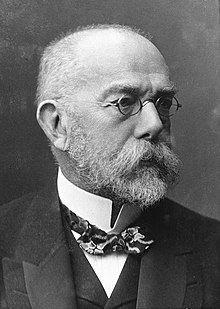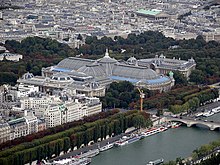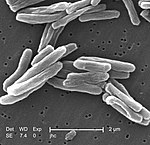|
International Congress on Tuberculosis
The International Congress on Tuberculosis was a series of major congresses held between 1899 and 1912 in which scientists and physicians exchanged information on tuberculosis, a significant cause of death at the time.[a] 1899 congress (Berlin) The first International Congress on Tuberculosis (German: Internationalen Tuberkulosekongress) was held at Berlin on the 24–27 May 1899. The congress was opened by Victor II, Duke of Ratibor in the presence of the Empress of Germany.[2] The congress was held in the Chamber of the Reichstag. Various papers were read on the nature of tuberculosis in man and animals, its diagnosis, pathology, and preventative and curative treatment. Most of the speakers were German. There was no general discussion, but the published proceedings were expected to be valuable.[2] About 180 delegates represented different governments, universities and other public bodies.[2] About 2,000 members attended the sessions, whose purpose was mainly to instruct doctors, officials and the general public. The speakers explained aspects of the subject and the actions that should be taken to prevent the spread of the disease and to treat it when present.[3] It was known by this time that tuberculosis was caused by a bacillus discovered by Professor Robert Koch of Berlin.[3] Infection was thought to usually be passed by phlegm coughed up by a sick person, dried into dust and then inhaled by a healthy person.[4] It was thought that tuberculosis "is not 'catching', in the popular sense of the word. The disease is not conveyed by the breath, nor even by coughing, except as a rare exception."[5] Milk was known to be an important means of infection, and eating poorly cooked contaminated meat could also cause infection, although rarely.[4] Means of prevention included free ventilation of houses and wholesome and abundant food. Milk should be boiled, and meat should be carefully inspected, or else the cattle tested for infection. Cures for the disease included abundant food, particularly of a fatty nature, and life in the open air.[6] 1901 congress (London)The British Congress on Tuberculosis was held in London on 22–27 July 1901. About 2,500 British and foreign delegates were invited, including many eminent pathologists and physicians. The Duke of Cambridge opened the congress on behalf of the king. Great stress was placed on the importance of early treatment, but it was also noted that the patient's dependents must often receive aid. Better sanitary arrangements were also seen as important, and improved housing for the poor. It was agree by all speakers that human sputum was the main vehicle of infection.[7] Professor Brouardel of Paris said, "The danger is in the sputum, which contains thousands of contagious germs. To expectorate on the ground is a disgusting and dangerous habit. Once this habit has quite disappeared, tuberculosis will decrease rapidly."[8]  At this meeting, Robert Koch, who had discovered the tubercle bacillus, announced that it was almost impossible for humans to catch the disease from cattle, and even if they did it would only be a very mild form.[9] He said,
John McFadyean of the Royal Veterinary College disputed this view.[10] Frederick Montizambert, Director General of Public Health of the Dominion of Canada, noted that this view was in absolute contradiction of two Royal Commissions whose members included experts such as Sir George Buchanan, Sir John Burdon-Sanderson, Sir Richard Thorne Thorne and Mr. Shirley Murphy. They found that "any person who takes tuberculous matter into the body as food, incurs risk of acquiring tuberculous disease." Montizambert wrote that "the feeling throughout the Congress seemed to be that Dr. Koch's statements were made prematurely, and upon insufficient data, and that, should they prove to be wrong, the amount of harm done may be incalculable."[11] Later Koch modified his views, but the belief that milk with live tubercle bacilli could be drunk without much risk persisted in Britain.[9] Resolutions adopted at the close of the congress included:
1905 congress (Paris) The International Congress on Tuberculosis (French: Congrès international de la tuberculose) was held in Paris on 2–7 October 1905 in the Grand Palais, which allowed all the attendees to collect in one building.[13] The Grand Palais was suitable for holding the large congress due to its great size and many rooms.[14] The French government made a large contribution to the cost. There were 3,500 delegates in all. They represented foreign governments, universities and special associations and committees, and there were also many doctors, surgeons, veterinarians and local administrators.[15] Émile Loubet, President of the French Republic, welcomed the attendees on the first day, and held a reception at the Élysée Palace after the congress closed. The Municipality of Paris gave a reception at the Hotel de Ville, and Le Figaro staged an “at home” where well known artistes performed. The president of the congress, Dr. Hérard, gave a soiree at the Hotel Continental.[13] The proceedings of the congress were reported in detail in the Paris papers, including Le Figaro, Le Matin and Le Journal.[16] The congress was divided into four sections, which met separately for about six hours daily: Medical Pathology, Surgical Pathology, Preservation and Assistance of Children, Preservation and Assistance of Adults, Social Hygiene.[17] Forty carefully prepared reports were published in advance, and several hundred special papers were prepared by members of the congress.[18] A museum on tuberculosis was kept open throughout October, with contributions from France, other European countries and the United States.[18] The exhibition was placed in the partially enclosed rooms and large vestibules leading to staircases on either side of the great hall, and in the galleries. The museum occupied the greater part of the right side of the ground floor, and included a careful arrangement of specimens prepared by leading pathologists and bacteriologists, as well as models and photomicrographs.[14] There were models of the grounds of various sanatoriums, with their woods and walks, hills and meadows, and of the internal facilities. There were maps of the distribution of sanitariums for the rich and for the poor, and photographs of patients in sanitariums, illustrating the life and method of treatment. There were also cases that showed various instruments and products associated with detection and treatment, with sales brochures.[19] 1908 congress (Washington, D.C.)  The 6th Congress was held in the United States in Washington, D.C., from 28 September to 3 October 1908.[20] Hundreds of the attendees came from Canada, Central and South America, Europe and Japan to obtain the latest information about tuberculosis from biological, economic and sociological perspectives. Outside the sessions they were feted at receptions and taken on tours of hospitals, clinics and sanatoriums.[21] A large number of papers were presented.[20] The congress organizers carefully vetted the papers to avoid the sensationalism and reports of "startling discoveries" given at the London and Paris congresses. The main focus was on the influence of housing conditions in the spread of the disease.[22] Some papers:
1912 congress (Rome)The 7th International Congress on Tuberculosis was held in Rome, Italy, on 14–20 April 1912.[26] Robert William Philip of the Royal Infirmary, Edinburgh told the congress,[27]
Notes
Citations
Sources
|
||||||||||||
